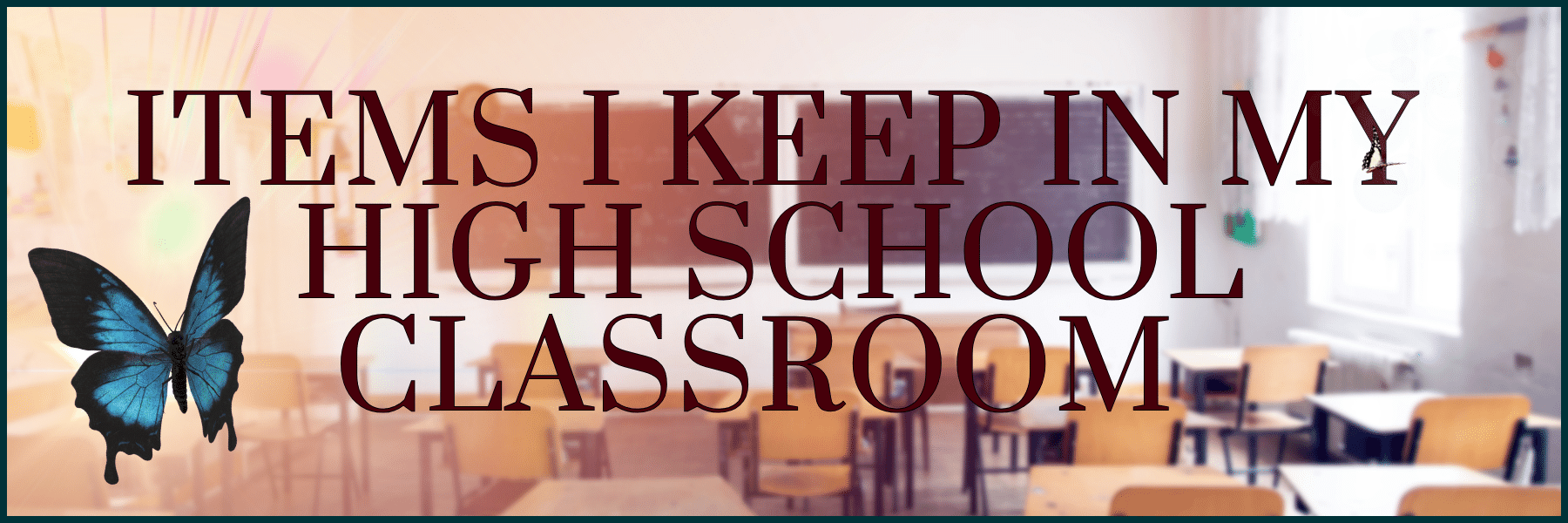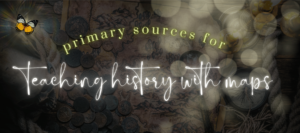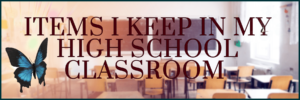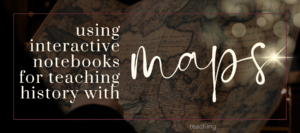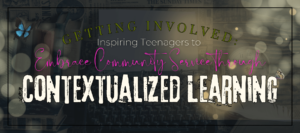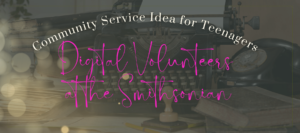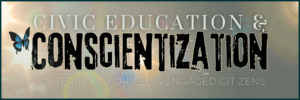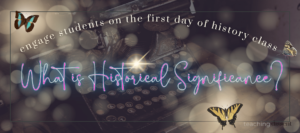Ok so… I don’t know if these items are classroom “must-haves” for ALL high school teachers, but here are some things I keep in my high school classroom that, in their small way, show my solidarity with my students. They go beyond the obvious cutesy gummy bears, bookmarks, hot chocolate/tea station and school supplies, etc. that are also definitely always a win, and are what kids thank me for again and again. Its not necessarily academics-related, and its definitely personality dependent, so while these specific items may not lend themselves to your specific classroom, the idea here is that when thinking about what supplies to bring to your high school classroom, I think its important to take a minute to connect with whatever part of yourself you still have that is still a kid. What would have made a difference to you in your day?
I think this is the key to showing our young people we are on their side– to first remember that we, to were their age once. As vulnerable, as clueless, as angry, confused, mischievous, forgetful… in short, we were little once, too.
With this in mind, what can you bring into your learning space that demonstrates love and mutual respect for your high school students in a frequency that will actually reach them?
It can be lots of things, honestly…. it depends so much on who you are and how you relate to your kids. But I will tell you: It’s not a generic “believe in your dreams” hot air balloon poster. What does that even mean? Especially to a kid? It’s not a prize for when you sit and stay. It’s not being tricked into behaving, or bribed into pretending to care… there is a chasm between teenagers and adults that is only further widened by anything performative. I swear, teenagers have some kind of sixth sense that allows them to just see right through everyone. My personal theory is that this very ability is why most adults are terrified of teenagers- their performance doesn’t work on the youth like it does on the rest of us. They just don’t buy it, and it bores them.
Solidarity is not expressed through pandering, through bribing, and certainly not through perpetuating dogma we ourselves don’t even buy into. Solidarity materializes when mutual humanity is recognized and honored.
And it is with this attitude that I have curated the items in my secondary classroom.
Chopsticks
The classroom supply item you never know you needed…. but once you have, you will start discovering endless uses for. Arts and crafts? Check. Forgot your hair tie? Check. Need to keep a window open? Check. Need to point at something but can’t reach it on your own? Check. I’m only half kidding.
Chopsticks, it turns out, are also actually an invaluable tool for teenagers, and a genius item to supply in your classroom. Just collect the extra ones you get from take-out! Instead of throwing them out or leaving them in a random drawer, I bring them to school and keep them in a designated container.
For teenagers, the need for these utensils is pretty much limitless, but I have found them the most helpful for kids eating Hot Cheetos. Don’t laugh, it’s true.
These very popular snacks leave the gnarliest bright red powder on the kids’ fingers, and it ends up getting everywhere. It’s a nightmare. Red fingerprints on not only their notebooks, backpacks, and pencils… but also MY desks, tables, chairs, turned-in assignments(that I am supposed to touch and grade? ew), doorknobs, pencil sharpeners, etc. And then I start complaining and threatening that there will be no food allowed in my room anymore, which we all know is all talk because it would give me yet another thing to police in an overcrowded classroom of giant teenagers whose only real crime is being hungry.
Bottom line: it’s gross.
ENTER: CHOPSTICKS! With these time-honored, traditional and easily stored wooden utensils, students can eat their favorite snack and NOT get grubby red toxic fingerprints all over everything in their path.
Everybody wins.
And somehow, up until this point, very few of them have thought of this, so they are more excited by the novelty of eating Cheetos with chopsticks than they are annoyed with you for curbing their behavior. Ha!
Added bonus- you can casually give etiquette tips on proper chopstick decorum. Real teachable moment. The benefits are endless here, really.
Bandaids
Ok but not the boring band-aids that any school nurse has. I mean the really cool bandaids. There are glitter bandaids, cartoon bandaids, Spongebob Squarepants bandaids, Spiderman Bandaids… remember those? Add them to your classroom supply list 🙂
Teenagers may look almost like real people, but let’s be real- they are still babies. To be clear, I am not saying to keep bandaids in your classroom so you can deal with bodily fluids on top of teaching. No. If there is actual blood, for the love of everything holy please send that child to the nurse’s office. Also, ew.
But listen, sometimes, there is a scratch or an “injury” that is clearly not about the wound on their skin. At their age, high-schoolers rarely get the fun band-aids anymore or any of the playfulness or affection from childhood. And It’s like we forget they are still kids.
When I was a kid, my teachers were the aunties (the tias, if you will), that I didn’t really get to have by virtue of growing up an immigrant. I loved and trusted them like we were related, and I think that was a large part of why I loved school so much- school was a place where I, myself, was loved. I grew up in a bubble where my teachers made us all handmade gifts, baked us things for celebrations and sometimes for tests (even in high school!), I wouldn’t have thought twice about needing a hug when I was sad. I realize that is not the case for many, if not most people. But oh, how I wish it could be….
Anyway, the point is- sometimes, pulling a kid aside (yes, even a 16 or 17-year-old kid) and presenting them with a selection of superhero bandaids to choose from because you noticed their current bandaid was falling off/their finger was bothering them/or whatever else it may have been- can be the equivalent of a hug without making it weird.
Something that says to students “I see you, and you matter.” In an educational system where children have been reduced to numbers, it’s a glimmer of a moment when you can find humanity.
In over ten years, I have yet to see a single kid NOT light up when presented with a selection of superhero/glitter/cartoon character bandaids… and here is the thing: they have to actually pause and think seriously about which one to pick. It can be a tough decision, you see. And the fact that you, the teacher -figure of authority- has these on hand, de-institutionalizes the interaction within the walls of your classroom instantly.
It might only be a few kids throughout the year, but I promise it will be worth the few dollars investment.
Coloring Pages and Pencils
I think the trendy term these days is a “calming corner”, or something? Whatever. You know what I mean- A designated section of the room where there is a ready supply of really great coloring pages and coloring utensils. I spend time setting this up in my classroom at the beginning of the year, and then assign its upkeep in specific tasks and checkpoints to TA’s at regular intervals throughout the week.
When possible (especially when I was teaching middle school), I would add coloring pages that were thematically related to whatever the content was in our current unit- I think mostly because my teachers did this for us when I was in school and it adds to the happy memories I have of school. Learning was fun for me, and I am realizing more and more how lucky I was. Privileged, even? Ha.
Anyway, whether or not the coloring pages are thematically related to the unit content, or if I kept inspirational quotes, mandalas, flowers, or whatever…. The “coloring corner” in my classroom actually always got used. I welcomed students to create templates for me to photocopy and let other students color, promoting their work, if you will, among their own kind, but mostly I would get pages from adult coloring books or find (read:pirate) things online.
This space was accessible for kids at any point in the day, and sometimes, once I earned my students trust, students that weren’t even in my class would sneak in and color quietly. Sometimes they would stop by and ask for a sheet or two to take with them.
The benefits of coloring are real, and I promoted the whole coloring thing as a valuable activity because of the mindfulness thing. And I meant it, as this is not without merit! Its actually really great and relaxing and fun. I myself am a coloring fool. Its good for you.
But taking this all one step deeper, the value of a classroom coloring corner- the coloring pages, pencils (or pens, whatever)- extend beyond the mindfulness trope:
Fostering safe spaces–
It provides a third, neutral space that allows kids to connect with you, with each other, or with themselves, that isn’t about their grades, attendance, or missing assignments. Its a built-in refuge, hiding in plain sight.
Its a place to take a quick side conversation, its a place for a kid to take a break to self-regulate, its a safe place within the confines of your classroom that allows that kid who is going through hell to stay with everyone but close an invisible door and take a breath.
Coca-cola for migraines
Coca cola helps with migraines. Specifically coca-cola. I’m not exactly sure what it is, but there is something in coca-cola that helps with migraines… when I looked it up, there is of course a divide between what the “research” can prove, and what the reddit and blogosphere report. If you have ever had anything resembling a migraine, you understand when I say you could not care less what the scientists do or don’t say, you just care what works. And for me, coca-cola (and aspirin, if exederin isn’t available) actually works, if I take it early enough.
As a person with chronic migraine, I am always prepared for one to come on at any time; it could be a change in air pressure, it could be those god-awful fluorescent lights, it could be that I am staring too hard at a screen, it could be that there isn’t enough air circulation…. Our building is falling apart. And if I am getting one, chances are other chronic migraine sufferers(usually girls) are too.. Obviously, you can’t give kids any actual pain relief like aspirin or exederin (which also helps migraines), so if it’s a giant migraine or a headache send the kid to the office or whatever you are supposed to do. I also wouldn’t advertise that you have cokes, or all of a sudden everyone is going to come out of the woodwork announcing they have migraines every day… no. I buy a bunch of the mini cans of coke and keep them either in my mini fridge or the back of a cupboard where I can get one discreetly, and give them to the student while everyone is busy with independent work.
Of course, it goes without saying, that if you have a student with migraines in your classroom, don’t use fluorescent lights, and keep the volume down, or the coke is useless.
Side note- it has to be the normal kind of coke. Meaning full sugar, full fat, full of everything. None of this Diet Coke, Coke Zero, or any of the other impostor Cokes. Sorry. I know your teeth will hate you and, etc. etc., but… lesser of the evils, I guess? Idk. If you have the capacity to care about anything else, then I am guessing you don’t get migraines, so this isn’t super relevant to you, and it won’t necessarily be a point of connection for you with students. But if it is, and you can empathize, this has let me not only help, but reach out and support kids in their most vulnerable moments, in a way that the official structures really just aren’t set up to do, and in a way that doesn’t violate any rules.
Worst case scenario, it’s just a can of soda and won’t hurt anyone.
Again. It’s not a magical elixir or anything, but if you drink it at the onset of the aura, and remain in the dark and without noise, a coke can actually help with migraine.
I write this post at the very beginning of creating this blog. It’s a funny thing, to start a blog. What do you even write about? How do you center on a niche? Why am I even doing this? It’s overwhelming, daunting, and the fodder for self-doubt. I decided to write about these tiny, seemingly insignificant moments in my “classroom management”, because when I reflect upon what made my classroom different than other classrooms, and what makes any teacher’s classroom different than anyone else’s what it really comes down to is who we are as individuals.
Who we are as humans, if you will.
And in a field that is increasingly institutionalized, it is so easy to lose sight of your own humanity, to become the institution- mostly because it’s safer to do so. To this effect, the kids become our products- the measure of our success. This is based on numbers, whether it’s performance, attendance, scores, … our young people are reduced to numbers on a spreadsheet.
I understand that the People in Charge need to measure proficiency, that funding has to be allocated and secured, success must be measured if it is to be communicated… and so on and so forth.
I understand… I just don’t care.
Because ultimately, this is not the purpose of public education as an institution within a functioning democracy, as far as I am concerned.
So.
How does all of this relate to me keeping glitter band-aids in a high school classroom, or collecting my take-out chopsticks in a little pink Target tin behind my teacher-desk and giving it to the teenager eating Flaming Hot Cheetos?
Because keeping items like these in your classroom creates a safe space.
The very act of having items like these, which may appear merely silly and playful, is actually all about connecting with your students as children and answering their emotional bids.
It’s about communicating that each individual kid is seen, known, and accepted exactly as they are.
It’s about being concerned about what concerns them, even if you have to slow down and remind yourself to do it. Because it’s recognizing that these kids are kids. Fellow human beings. It’s proving by example that I see and value my students as people before I see them as a member of the institution where I work.
It’s keeping front and center that the reason I am a teacher is because their lives matter to me.
Related Posts

- Exploring Historical Significance on the First Day of History Class (How I build trust and establish classroom norms with my students by diving straight into content)
- How to Teach about Feminism (How my students taught me about incels and how I followed their lead to develop an inquiry unit to explore what feminism really means)
- Building Blocks for a Feminist Classroom (How to structure your learning environment so that it fosters engagement and empowers young people to show up as their true selves)

